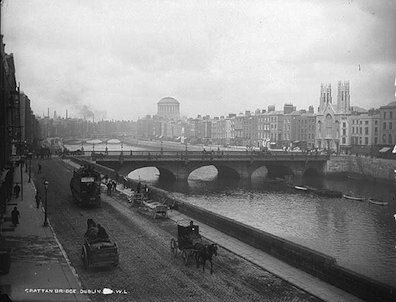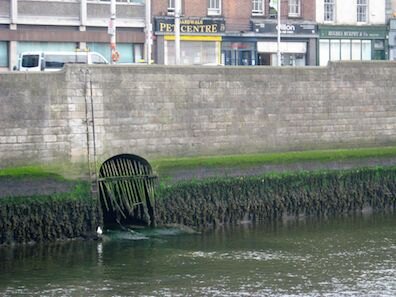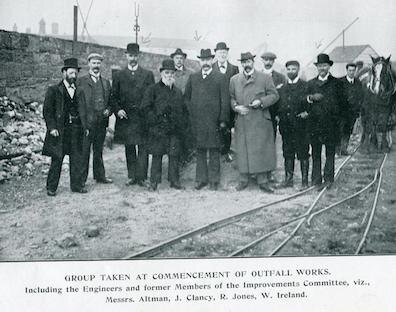The Joyce Project : Ulysses : Sewage
Sewage
Sewage
In Brief
In 1904 Dublin had covered sewers (an improvement over the open drains and backyard cesspools of the 18th century), but no sewage treatment facilities. The River Liffey served as the ultimate sewer, carrying vast amounts of untreated human waste into Dublin Bay. The novel casts many glances at this urban pollution problem, and a couple more at a major effort that was being made to improve the infrastructure by routing all the sewage to a treatment plant through drains laid under the quays. Wandering Rocks makes an anti-imperial gesture out of the filth.
Read More
In Proteus Stephen notices places on the bayshore where the downstream effects are evident: "Unwholesome sandflats waited to suck his treading soles, breathing upward sewage breath. He coasted them, walking warily." Gifford notes that "the inshore waters of Dublin Bay, particularly just south of the mouth of the Liffey, where Stephen is walking, were notoriously polluted" (51-52).
Shellfish were affected by the bacteria-infested waters, causing periodic outbreaks of disease. Near the end of Nausicaa Bloom, who is sitting near where Stephen was walking, reflects, "Better not stick here all night like a limpet," and soon afterward he is thinking of the human beings who eat such mollusks: "Poor man O'Connor wife and five children poisoned by mussels here. The sewage. Hopeless." He has similar thoughts about oysters in Lestrygonians: "Unsightly like a clot of phlegm. Filthy shells. Devil to open them too. Who found them out? Garbage, sewage they feed on." He goes on to think about the months-with-an-R rule: "June has no ar no oysters." In the same episode, he entertains the thought of swimming in the Liffey: "If I threw myself down? Reuben J's son must have swallowed a good bellyful of that sewage."
One of the Liffey's tributaries, Poddle River, makes an
appearance as a bearer of sewage in Wandering Rocks. By
the time represented in the novel it had been confined to a
brick tunnel and covered over with city pavements, and it
emptied into the Liffey through a culvert. As the viceregal
cavalcade passes by this culvert, the sewage-choked stream
offers open-mouthed, scathing homage: "From its sluice
in Wood quay wall under Tom Devan's office Poddle river hung
out in fealty a tongue of liquid sewage." Gifford
notes that Joyce took fictional license to move this culvert
to the Wood Quay wall from its actual location in the
Wellington Quay wall, about 350 yards east. Why might have he
done so? One possibility is that he wanted to associate the
scorn for British rule with his father's friend Tom Devin.
The Dublin Main Drainage Scheme, discussed for decades in the late 19th century before work finally began, devised a way of cleaning up the Liffey. New sewer lines were built under the quays on both banks of the river, intercepting the outflow before it reached the Liffey and carrying it east to a wastewater treatment plant in Ringsend. There, the solids were settled out for disposal in the Irish Sea, and the liquids released into the harbor near the Pigeon House for the tides to disperse. The project was completed in 1906; in 1904 it was still an ongoing dream of civic improvement. As Hugh Kenner notes in his foreword to Joseph O'Brien's Dear, Dirty Dublin (1982), this was "long after such a procedure had been instituted in London, but turn-of-the-century Dublin was a retarded city indeed" (viii). For more on the scheme, see the Greater Dublin Drainage website at www.greaterdublindrainage.com.
The novel glances at the work on this construction project in Hades when the funeral carriage passes "open drains and mounds of rippedup roadway before the tenement houses." The location here is Ringsend, site of the not-yet-completed treatment plant. Another, more comical allusion comes in Lestrygonians, when Tom Rochford, who is working on the project, comes into Davy Byrne's pub. "—How is the main drainage? Nosey Flynn asked, sipping. / For answer Tom Rochford pressed his hand to his breastbone and hiccupped. / —Would I trouble you for a glass of fresh water, Mr Byrne? he said." The water is for dissolving some "powder from a twisted paper" to treat a problem in Rochford's main drainage: "—That cursed dyspepsia, he said before drinking."


